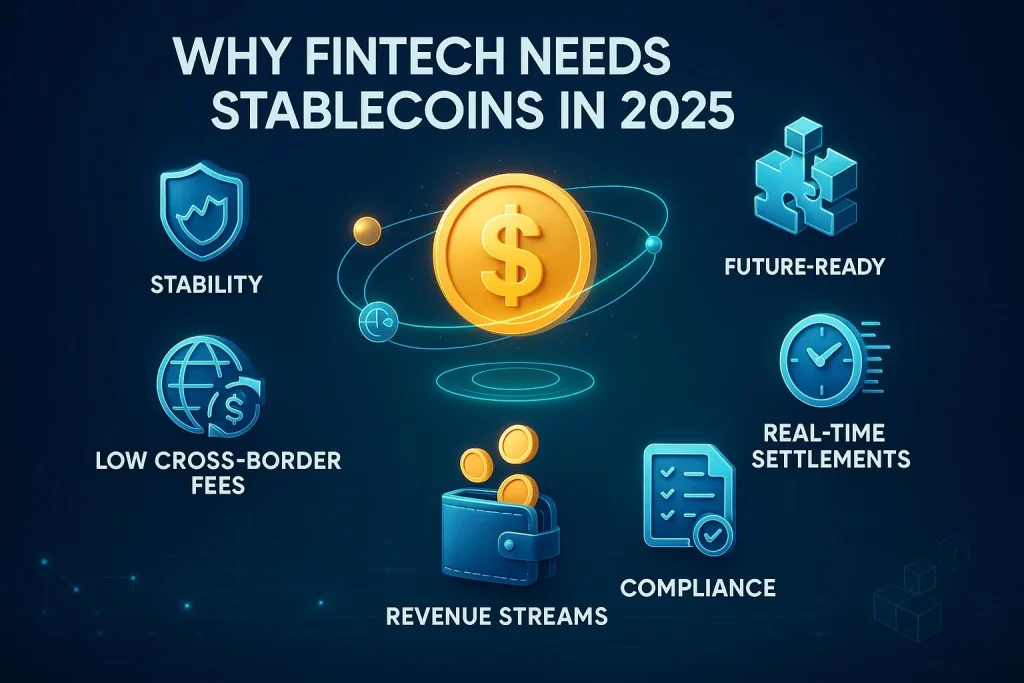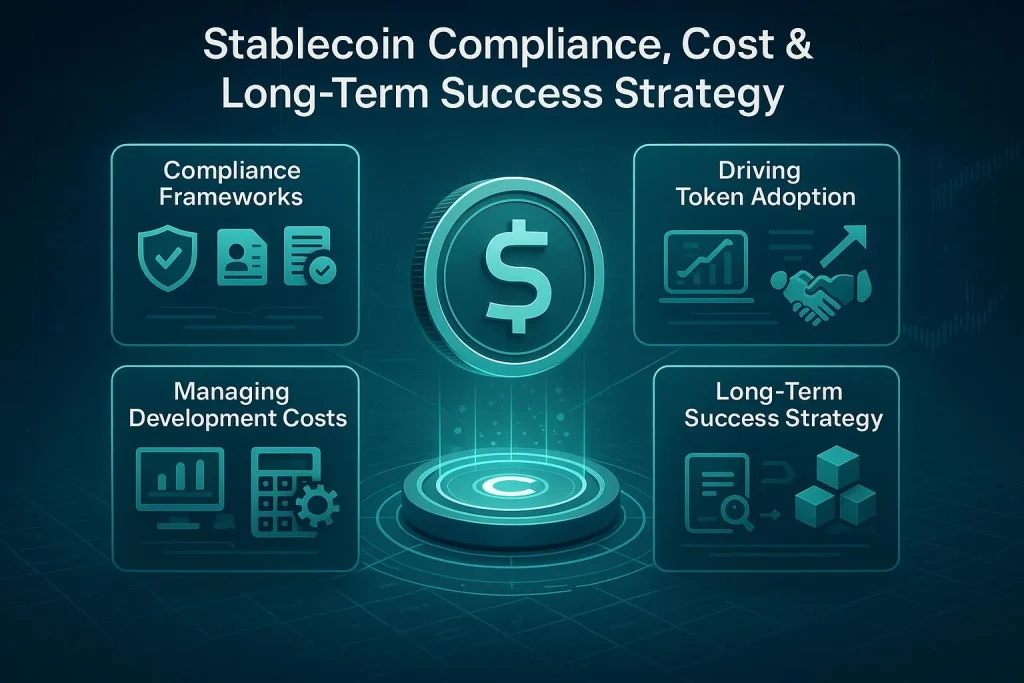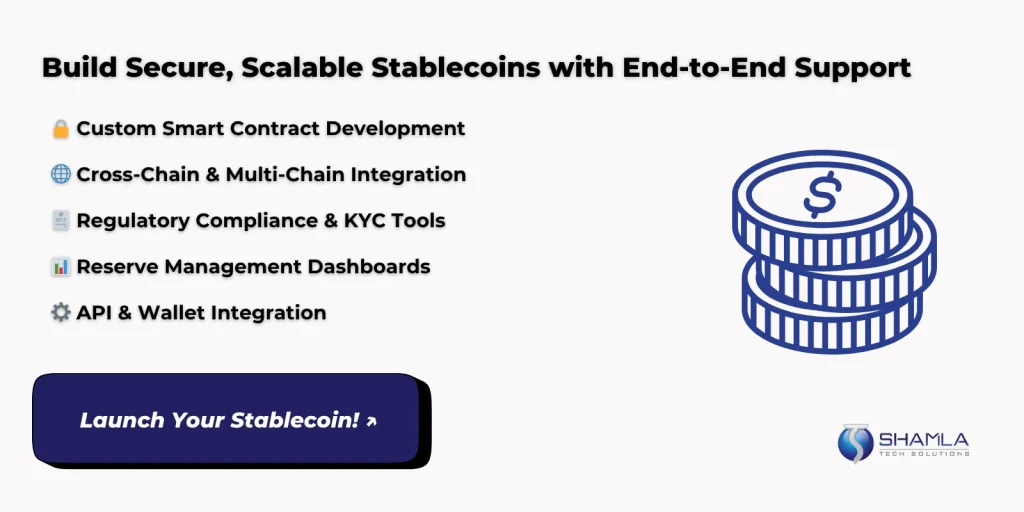In 2025, fintech firms handling $2.5 trillion in payments eye stablecoin development for fintech companies to slash costs and boost speed. But how do you build a safe, compliant stablecoin?
This guide covers the full process: defining asset backing, designing smart contracts, integrating KYC/AML checks, and connecting with payment rails.
You’ll learn about stablecoin use cases in fintech – from cross-border settlements to payroll systems and get a clear roadmap for launching your own digital currency.
Why Fintech Needs Stablecoins in 2025

1. Enhancing Transaction Stability
Stablecoin development for fintech companies locks each token’s value to a real asset, like the US dollar. This steady link cuts wild swings in crypto, so payment apps can rely on clear pricing. With fintech blockchain integration, platforms tap secure ledgers to track every transfer without third‑party delays.
That makes stablecoin cross-border payments predictable and fast, since currency changes happen on‑chain in seconds. Developers set up smart contracts that release tokens only when checks pass, keeping standards high. Built this way, digital currency blends crypto speed with the trust of real money, letting fintechs offer solid services without sudden losses.
2. Reducing Cross‑Border Costs
Fintechs face hefty fees when moving cash across borders. Through stablecoin development for fintech companies, teams embed token issuance and redemption directly into their apps. That cuts out banks and slashes fees to a fraction. For stablecoin cross-border payments, transactions run on blockchains that charge minimal gas fees instead of bank charges.
Using stablecoin use cases in fintech like instant merchant settlements, businesses avoid exchange rate markups and cut settlement times from days to minutes. This approach drives down costs and widens profit margins, making digital currency a clear choice for firms that handle global money flows.
3. Enabling Real‑Time Settlements
Traditional payment systems group transactions and settle them in batches, which leads to processing delays and slower fund transfers. By adding fintech blockchain integration, companies can settle trades and invoices instantly on public or private chains. Stablecoin development for fintech companies ensures each token matches a real asset, so back‑end systems trust its value.
Among stablecoin use cases in fintech, real‑time payroll and supplier payouts stand out, because workers and vendors get funds the moment sales clear. Instant settlement cuts reconciliation work and clears credit lines faster. Companies get instant insight into their cash flow and can make faster decisions without waiting days for payments to settle.
4. Improving Compliance and Governance
Choosing the right types of stablecoin means picking models that fit your rules. Fiat‑backed tokens use bank reserves, crypto‑backed use locked assets, and algorithmic types adjust supply automatically. Each path demands checks: proof of reserves, on‑chain audits, or code audits.
Clear governance structures and regular reporting build trust with regulators. Strong controls speed stablecoin adoption by turning audits from months to days. This discipline helps fintechs win licenses and operate across borders without surprises.
5. Expanding Revenue Streams
Beyond payments, tokens open new services. Fintechs can charge minting fees or earn interest on reserve assets, showing how stablecoin issuers make money. Platforms can offer yield products, lending tokens at small spreads or staking on partner chains.
Listing your token among the top 10 stablecoins in key wallets can drive user growth and network effects. As demand rises, transaction volumes grow and fee revenues climb. This model turns a basic payment token into a multi‑service hub, letting fintechs tap markets for lending, trading, and merchant tools under one roof.
6. Future‑Proofing Infrastructure
Stablecoin development for fintech companies creates a foundation that scales as needs grow. With stablecoin use cases in fintech spanning remittances, merchant payouts, and credit lines, firms can add new features by reusing core code. Using on‑chain identity and secure wallets, teams can layer loyalty points, micro‑investments, or insurance products without rebuilding rails.
Every extra use case relies on the same token logic, lowering development time. And because stablecoin cross-border payments run on open protocols, fintechs stay compatible with emerging rails and partners. This modular setup keeps platforms ready for tomorrow’s challenges.
How to Build a Stablecoin for Your Fintech Company?
1. Define Backing Model and Tech Stack
Start by choosing how tokens stay stable. Choose whether to back the stablecoin with fiat currency, locked crypto assets, or a code-based system that adjusts supply automatically. This step drives every decision in stablecoin development for fintech companies, especially when you hire stablecoin developers with ledger expertise. Map your core requirements, then evaluate stablecoin platform providers that offer modular APIs and compliance toolkits.
Outline development languages (Solidity, Rust) and layer‑1 or layer‑2 chains. Document your asset‑backing rules, redemption flow, and audit checkpoints. Clear specs let teams focus on building rather than guessing. This foundation sets up a reliable token and speeds future additions. Plus, it answers “how to create a stablecoin” with direct, code‑level detail.
2. Design Legal Framework and Reserve Management
Next, craft a legal structure covering licensing, KYC, and reserves. Work with counsel to align your model with banking rules and stablecoin regulation. Define reserve custody and reporting frequency. Choose between a custom build or white label stablecoin services offered by a stablecoin development company, so you can meet audit requirements out of the box.
Compare stablecoin development services by checking/comparing: proof‑of‑reserves dashboards, compliance plugins, and API user management. Embed legal checks into your architecture. Solid governance reduces risk and speeds approvals, so tokens launch under a compliant shield without last‑minute rewrites.
3. Build and Audit Smart Contracts
With legal foundations in place, begin stablecoin smart contract development services or in‑house coding. Write mint, burn, and transfer logic using secure patterns. Integrate oracle feeds for off‑chain price data and multi‑sig wallets for reserve control. Develop both core and pause functions for emergency response.
After coding, run formal audits with top firms and fix any issues. This step is crucial in stablecoin development for fintech companies, so your token behaves predictably. Many stablecoin platform providers include audit gateways and testnets. A thorough audit report boosts confidence with regulators and partners.
4. Implement Governance and Compliance Controls
Set up on‑chain and off‑chain governance. Use DAO‑style voting or centralized boards to approve reserve changes, contract upgrades, or emergency stops. Embed compliance rules to block sanctioned addresses. Layer in identity checks so users pass KYC before minting or burning tokens.
This stage demonstrates how stablecoin development for fintech companies meets institutional standards. Partner with a stablecoin development company or access stablecoin smart contract development services to implement role‑based access controls. A clear policy on amendments, audits, and dispute resolution shows regulators you’ve thought through every scenario.
5. Integrate Cross‑Chain Bridges
Expand reach by enabling cross-chain stablecoin transfers. Develop or integrate bridges that lock tokens on one chain and mint equivalents on another. Verify messages with light clients or relayers to avoid fraud. Consider gas‑efficient bridge designs to keep user fees low.
Monitor liquidity pools and rebalancing scripts to maintain peg across networks. Factor in the cost of stablecoin development for bridges, this tends to be higher due to security demands. Engaging specialized stablecoin platform providers that support multiple ecosystems lets you plug into existing infrastructure quickly.
6. Launch, Monitor, and Optimize
Go live on your primary blockchain and any connected chains. Monitor blockchain data like transaction count, price stability issues, and reserve levels to ensure the stablecoin functions properly. Build dashboards for operations teams and alert systems for anomalies. As demand grows, you may need multi-chain stablecoin support to reach new audiences.
You can modify smart contracts through governance to introduce new features or improve performance as needed. This launch phase showcases stablecoin development for fintech companies in action. Evaluate performance and plan upgrades to improve gas costs or expand collateral options.
7. Scale with White‑Label and Multi‑Chain Support
Once stablecoin adoption rises, offer white label stablecoin services to partners who want custom tokens under your framework. Reuse your audited code and compliance modules across offerings. Enable multi-chain stablecoin deployments by cloning contracts on new networks and configuring oracles.
Keep hiring stablecoin developers to handle bridge updates and feature rollouts, while using platform providers to simplify chain connections. This setup helps fintechs launch new tokens quickly and scale faster.
Stablecoin Compliance, Cost & Long-Term Success Strategy

1. Compliance Frameworks
Fintech firms must follow clear rules before issuing tokens. Start by mapping regional stablecoin regulation so your token meets legal checks. Pick stablecoin platform providers that offer built‑in compliance tools, like proof‑of‑reserves dashboards and on‑chain audit logs. Use fintech blockchain integration to connect your token system with KYC/AML services, ensuring every user is verified.
This approach lets you launch under a solid legal shield and avoid fines. For stablecoin development for fintech companies, embedding compliance at the code level ensures tokens only mint when reserve audits pass. A tight framework wins trust from regulators and partners.
2. Managing Development Costs
Plan the stablecoin development cost upfront to avoid surprises and align your budget with project needs, including coding, audits, legal setup, and platform integration. Compare quotes from stablecoin development solutions and in‑house builds. Outsourcing to experts can cut costs on audits, code security, and support. Look for stablecoin platform providers that bundle APIs, smart contract templates, and compliance modules, this reduces custom coding time.
Allocate funds for legal counsel, oracle feeds, and testnet usage. For stablecoin development for fintech companies, clear cost planning avoids sudden overruns. Track spending per module like wallet integration, mint/burn logic, cross‑chain bridges and adjust scope to stay within budget without sacrificing safety or performance.
3. Driving Token Adoption
Boost stablecoin adoption by offering real value: instant settlements and low fees. Use fintech blockchain integration to plug tokens into payment apps, lending platforms, and merchant tools. Give clear guides on how stablecoin issuers make money, such as minting fees and interest on reserves.
Partner with wallets and exchanges to list your token among the top 10 stablecoins in key markets. Offer incentives like reduced fees for early users or cashback in token form. Clear documentation and easy‑to‑use SDKs from stablecoin platform providers help developers integrate fast. Strong utility draws users and cements your token in real workflows.
4. Long‑Term Success Strategy
Plan for growth by choosing stablecoin development solutions that scale. Reuse audited smart contracts across new services, from payroll to lending. Work with stablecoin platform providers that support modular upgrades and multi‑network deployments. Track on‑chain metrics and adapt governance based on feedback.
Study the top 10 stablecoins for feature ideas, like reserve transparency or flexible collateral. For stablecoin development for fintech companies, a modular setup cuts time when launching new tokens or adding chains. Maintain regular audits and clear reporting to sustain trust. A flexible core lets you add features quickly without rebuilding from scratch.
Conclusion
Issuing a dedicated stablecoin gives fintech companies precise control over transaction costs, settlement speed, and liquidity management. It boosts transparency by tying tokens to on‑chain proof of reserves and simplifies regulatory reporting. Custom tokens integrate seamlessly with existing platforms, enabling programmable payments, real‑time audits, and tailored financial products that drive growth.
Shamla Tech is a stablecoin development company which has helped several fintech companies to develop their own stablecoin. Our end-to-end stablecoin development services cover design, smart contract coding, audits, compliance, and cross-chain integration.
We deliver custom stablecoins with guaranteed reserve backing, real-time monitoring, and 24/7 support, helping fintech firms worldwide launch reliable digital currencies in 8 – 12 weeks with flexible supply control and costs.
Ready to launch your own stablecoin?
Contact Shamla Tech today to transform your fintech ecosystem!






